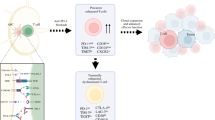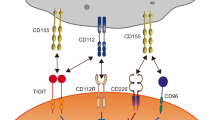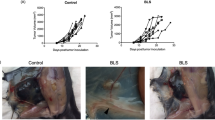Abstract
Melanoma is the deadliest form of skin cancer and surgery is currently the most effective treatment. However, there are situations where surgery fails or is not an option to treat melanoma patients. Immunotherapy such as immune checkpoint blockade (e.g., anti-PD-1) can be effective as an alternative treatment for melanoma patients; however, the percentage of melanoma patients that exhibit complete responses from anti-PD-1 monotherapy is low, and a hostile immunosuppressive tumor microenvironment may be at least partly responsible. Resiquimod (RSQ) is an imidazoquinolinamine derivative and TLR-7/8 agonist that could enhance the antitumor activity of immune checkpoint blockade when these agents are combined as a treatment for melanoma. Here, the effect of combining systemic anti-PD-1 and locally administered RSQ on the survival of melanoma-challenged mice was tested. Our results demonstrated that anti-PD-1 in combination with RSQ can significantly prolong the survival of melanoma-challenged mice, compared to untreated mice and mice treated with anti-PD-1 alone. In addition, the in vitro studies showed that RSQ can mediate a direct anti-proliferative effect on melanoma cells. In conclusion, the combination of RSQ and anti-PD-1 may be a promising treatment for melanoma patients, especially as both treatments have already been used independently to safely treat melanoma patients.
Graphical Abstract





Similar content being viewed by others

References
Bong AB, Bonnekoh B, Franke I, Schön MP, Ulrich J, Gollnick H. Imiquimod, a topical immune response modifier, in the treatment of cutaneous metastases of malignant melanoma. Dermatology. 2002;205(2):135–8.
Redondo P, de Olmo J, de Cerio AL-D, Inoges S, Marquina M, Melero I, et al. Imiquimod enhances the systemic immunity attained by local cryosurgery destruction of melanoma lesions. J Invest Dermatol. 2007;127(7):1673–80.
Van Zeijl M, Van Den Eertwegh A, Haanen J, Wouters M. (Neo) adjuvant systemic therapy for melanoma. Eur J Surg Oncol (EJSO). 2017;43(3):534–43.
Austin E, Mamalis A, Ho D, Jagdeo J. Laser and light-based therapy for cutaneous and soft-tissue metastases of malignant melanoma: a systematic review. Arch Dermatol Res. 2017;309(4):229–42.
Brahmer JR, Drake CG, Wollner I, Powderly JD, Picus J, Sharfman WH, et al. Phase I study of single-agent anti–programmed death-1 (MDX-1106) in refractory solid tumors: safety, clinical activity, pharmacodynamics, and immunologic correlates. J Clin Oncol. 2010;28(19):3167.
Brahmer JR, Tykodi SS, Chow LQ, Hwu W-J, Topalian SL, Hwu P, et al. Safety and activity of anti–PD-L1 antibody in patients with advanced cancer. N Engl J Med. 2012;366(26):2455–65.
Dong H, Strome SE, Salomao DR, Tamura H, Hirano F, Flies DB, et al. Tumor-associated B7–H1 promotes T-cell apoptosis: a potential mechanism of immune evasion. Nat Med. 2002;8(8):793.
Postow MA, Callahan MK, Wolchok JD. Immune checkpoint blockade in cancer therapy. J Clin Oncol. 2015;33(17):1974.
Larkin J, Chiarion-Sileni V, Gonzalez R, Grob J-J, Rutkowski P, Lao CD, et al. Five-year survival with combined nivolumab and ipilimumab in advanced melanoma. N Engl J Med. 2019;381(16):1535–46.
Darvin P, Toor SM, Nair VS, Elkord E. Immune checkpoint inhibitors: recent progress and potential biomarkers. Exp Mol Med. 2018;50(12):1–11.
Schmid D, Park CG, Hartl CA, Subedi N, Cartwright AN, Puerto RB, et al. T cell-targeting nanoparticles focus delivery of immunotherapy to improve antitumor immunity. Nat Commun. 2017;8(1):1747.
Daud AI, Loo K, Pauli ML, Sanchez-Rodriguez R, Sandoval PM, Taravati K, et al. Tumor immune profiling predicts response to anti–PD-1 therapy in human melanoma. J Clin Investig. 2016;126(9):3447–52.
Guilloux Y, Viret C, Gervois N, Dréan EL, Pandolfino M-C, Diez E, et al. Defective lymphokine production by most CD8+ and CD4+ tumor-specific T cell clones derived from human melanoma-infiltrating lymphocytes in response to autologous tumor cells in vitro. Eur J Immunol. 1994;24(9):1966–73.
Viret C, Gervois N, Guilloux Y, Le Dréan E, Diez E, Jotereau F, et al. T cell activation by antigens on human melanoma cells—co-stimulation by B7–1 is neither sufficient nor necessary to stimulate IL-2 secretion by melanoma-specific T cell clones in vitro. Int Immunol. 1995;7(10):1535–43.
Chen DS, Mellman I. Elements of cancer immunity and the cancer–immune set point. Nature. 2017;541(7637):321–30.
Gibson SJ, Lindh JM, Riter TR, Gleason RM, Rogers LM, Fuller AE, et al. Plasmacytoid dendritic cells produce cytokines and mature in response to the TLR7 agonists, imiquimod and resiquimod. Cell Immunol. 2002;218(1–2):74–86.
Asselin-Paturel C, Brizard G, Chemin K, Boonstra A, Garra A, Vicari A, et al. Type I interferon dependence of plasmacytoid dendritic cell activation and migration. J Exp Med. 2005;201(7):1157.
Marabelle A, Andtbacka R, Harrington K, Melero I, Leidner R, de Baere T, et al. Starting the fight in the tumor: expert recommendations for the development of human intratumoral immunotherapy (HIT-IT). Ann Oncol. 2018;29(11):2163–74.
Phuengkham H, Song C, Lim YT. A designer scaffold with immune nanoconverters for reverting immunosuppression and enhancing immune checkpoint blockade therapy. Adv Mater. 2019;31(42):1903242.
De Vrieze J, Louage B, Deswarte K, Zhong Z, De Coen R, Van Herck S, et al. Potent lymphatic translocation and spatial control over innate immune activation by polymer–lipid amphiphile conjugates of small-molecule TLR7/8 agonists. Angew Chem Int Ed. 2019;58(43):15390–5.
Rook AH, Gelfand JM, Wysocka M, Troxel AB, Benoit B, Surber C, et al. Topical resiquimod can induce disease regression and enhance T-cell effector functions in cutaneous T-cell lymphoma. Blood. 2015;126(12):1452–61.
Festenstein H, Garrido F. Tumour immunology: MHC antigens and malignancy. Nature. 1986;322(6079):502–3.
Garrido F, Cabrera T, Concha A, Glew S, Ruiz-Cabello F, Stern PL. Natural history of HLA expression during tumour development. Immunol Today. 1993;14(10):491–9.
Manome Y, Suzuki D, Mochizuki A, Saito E, Sasa K, Yoshimura K, et al. The inhibition of malignant melanoma cell invasion of bone by the TLR7 agonist R848 is dependent upon pro-inflammatory cytokines produced by bone marrow macrophages. Oncotarget. 2018;9(52):29934.
Caisová V, Vieru A, Kumžáková Z, Glaserová S, Husníková H, Vácová N, et al. Innate immunity based cancer immunotherapy: B16–F10 murine melanoma model. BMC Cancer. 2016;16(1):940.
Sabado RL, Pavlick A, Gnjatic S, Cruz C, Vengco I, Hasan F, et al. Phase I/II study of Resiquimod as an immunologic adjuvant for NY-ESO-1 protein vaccination in patients with melanoma. J Immunother Cancer. 2013;1(1):P272.
Royal RE, Vence LM, Wray T, Cormier JN, Lee JE, Gershenwald JE, et al. A toll-like receptor agonist to drive melanoma regression as a vaccination adjuvant or by direct tumor application. Am Soc Clin Oncol. 2017;35:9582–9582.
Vinod N, Hwang D, Azam SH, Van Swearingen AE, Wayne E, Fussell SC, et al. High-capacity poly (2-oxazoline) formulation of TLR 7/8 agonist extends survival in a chemo-insensitive, metastatic model of lung adenocarcinoma. Sci Adv. 2020;6(25):eaba5542.
Sun J, Liu Z, Yao H, Zhang H, Zheng M, Shen N, et al. Azide‐masked resiquimod activated by hypoxia for selective tumor therapy. Adv Mater 2023; Accepted Author Manuscript 2207733. https://doi.org/10.1002/adma.202207733
Tomayko MM, Reynolds CP. Determination of subcutaneous tumor size in athymic (nude) mice. Cancer Chemother Pharmacol. 1989;24:148–54.
El-Khattouti A, Selimovic D, Hannig M, Taylor EB, AbdElmageed ZY, Hassan SY, et al. Imiquimod-induced apoptosis of melanoma cells is mediated by ER stress-dependent Noxa induction and enhanced by NF-κB inhibition. J Cell Mol Med. 2016;20(2):266–86.
Kalb ML, Glaser A, Stary G, Koszik F, Stingl G. TRAIL+ human plasmacytoid dendritic cells kill tumor cells in vitro: mechanisms of imiquimod-and IFN-α–mediated antitumor reactivity. J Immunol. 2012;188(4):1583–91.
Jones E, Dahm-Vicker M, Simon AK, Green A, Powrie F, Cerundolo V, et al. Depletion of CD25+ regulatory cells results in suppression of melanoma growth and induction of autoreactivity in mice. Cancer Immun. 2002;2:1.
McCarter MD, Baumgartner J, Escobar GA, Richter D, Lewis K, Robinson W, et al. Immunosuppressive dendritic and regulatory T cells are upregulated in melanoma patients. Ann Surg Oncol. 2007;14(10):2854–60.
Kleffel S, Posch C, Barthel Steven R, Mueller H, Schlapbach C, Guenova E, et al. Melanoma cell-intrinsic PD-1 receptor functions promote tumor growth. Cell. 2015;162(6):1242–56.
Sallam MA, Shields CW IV, Prakash S, Kim J, Pan DC, Mitragotri S. A dual macrophage polarizer conjugate for synergistic melanoma therapy. J Control Release. 2021;335:333–44.
Fernández I, Peña A, Del Teso N, Pérez V, Rodríguez-Cuesta J. Clinical biochemistry parameters in C57BL/6J mice after blood collection from the submandibular vein and retroorbital plexus. J Am Assoc Lab Anim Sci. 2010;49(2):202–6.
Funding
A.K.S acknowledges support from the NIH (P30 CA086862) and the Lyle and Sharon Bighley Chair of Pharmaceutical Sciences. S.T acknowledges support from a Royal Thai Government Scholarship.
Author information
Authors and Affiliations
Contributions
All authors contributed to the conception and design of the work as well as drafting, revising and final approval of the published manuscript.
Corresponding authors
Ethics declarations
Conflict of Interest
The authors declare no competing interests.
Additional information
Communicated by Aliasger Salem.
Publisher's Note
Springer Nature remains neutral with regard to jurisdictional claims in published maps and institutional affiliations.
Supplementary Information
Below is the link to the electronic supplementary material.
Rights and permissions
Springer Nature or its licensor (e.g. a society or other partner) holds exclusive rights to this article under a publishing agreement with the author(s) or other rightsholder(s); author self-archiving of the accepted manuscript version of this article is solely governed by the terms of such publishing agreement and applicable law.
About this article
Cite this article
Tambunlertchai, S., Geary, S.M., Naguib, Y.W. et al. Anti-melanoma Effects of Resiquimod (RSQ) In Vitro and in Combination with Immune Checkpoint Blockade In Vivo. AAPS J 25, 57 (2023). https://doi.org/10.1208/s12248-023-00824-3
Received:
Accepted:
Published:
DOI: https://doi.org/10.1208/s12248-023-00824-3



